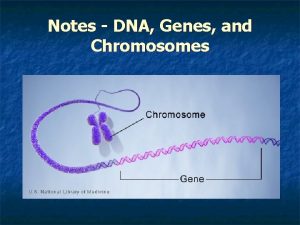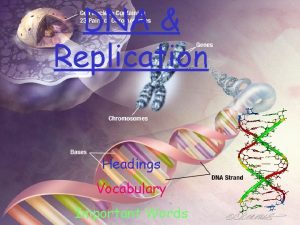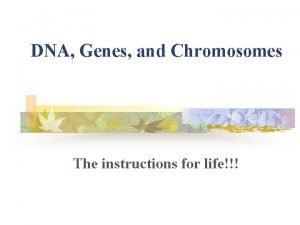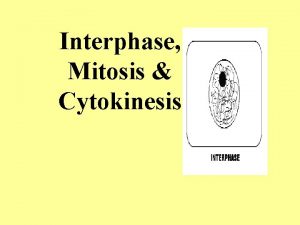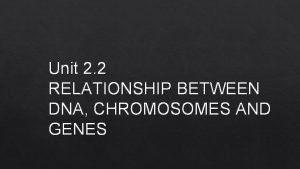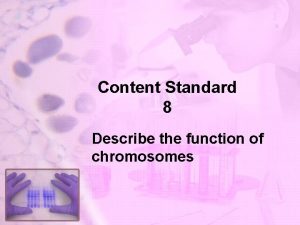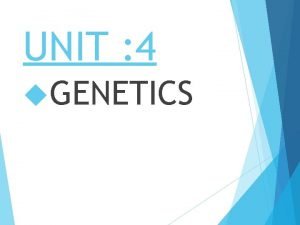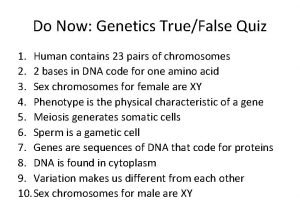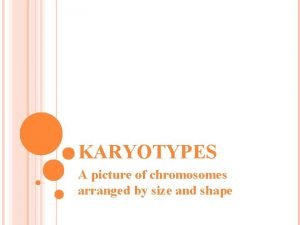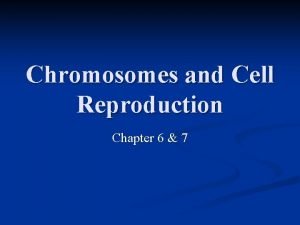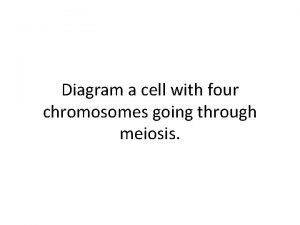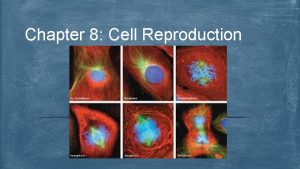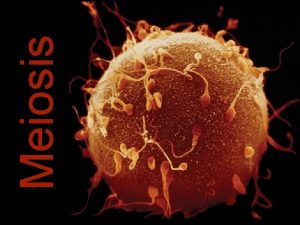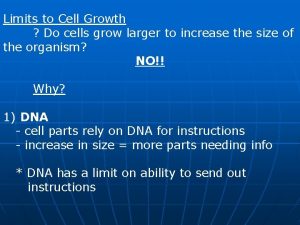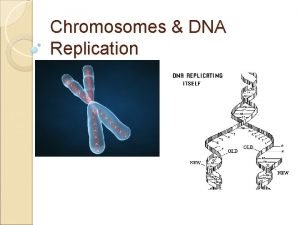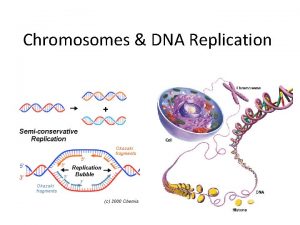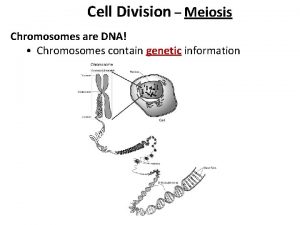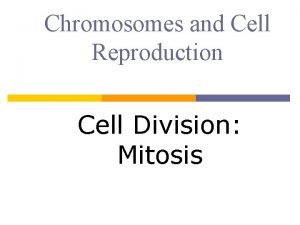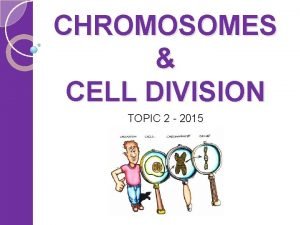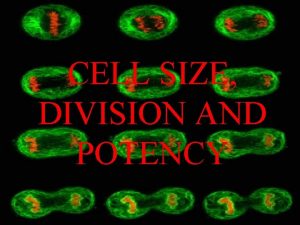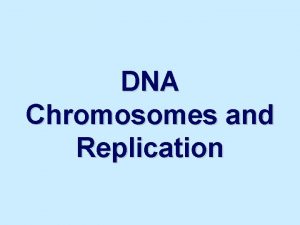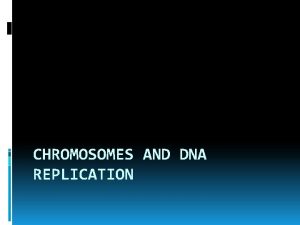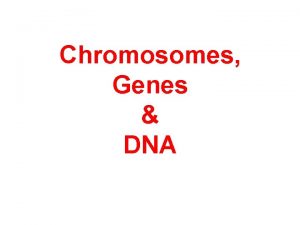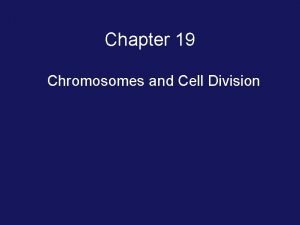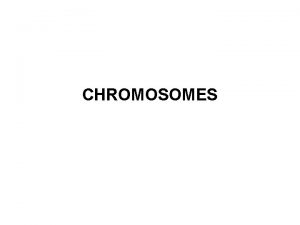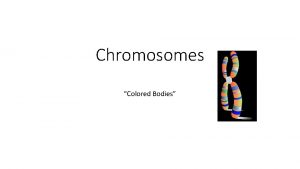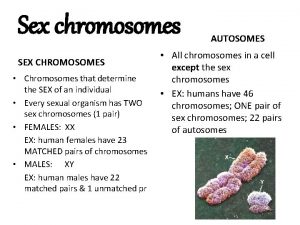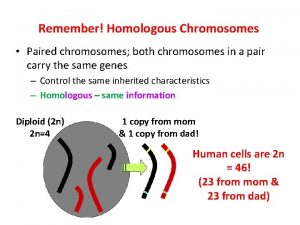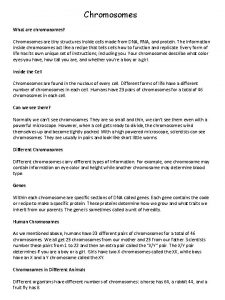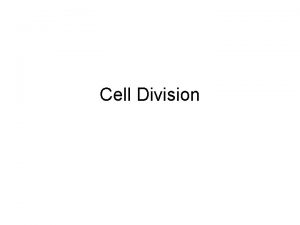Chromosomes and Cell Division DNA Limits Cell Size



























- Slides: 27

Chromosomes and Cell Division

DNA Limits Cell Size n n Cell cannot survive unless there is enough DNA to support the protein needs of the cell In some really large cells are multinucleated – More nuclei = more DNA = quick, efficient protein manufacturing to meet large cell needs

Prokaryote Cell Division n n Bacteria Circular DNA Reproduce by binary fission = 2 daughter cells DNA copied Know steps

n Cell division—making 2 new cells from 1 parent cell n New cells are (and have to be) Genetically IDENTICAL n Why? When? Who? How? n n n Cell Reproduction

Eukaryotes —the Who n Somatic cells—mitosis – Growth & replacement of lost, dead or damaged

Cell Cycle n n • G 1: 1 st growth phase major part n. S: "synthesis" DNA replicates; 2 copies G 2: 2 nd growth phase; microtubules made M: mitosis C: cytokinesis 2 daughter cells

• G 1 checkpoint—cell growth—are conditions favorable to divide (yes—S phase; no—rest or stop) • G 2 checkpoint— enzymes edit and repair mistakes made during replication • M checkpoint— triggers exit from mitosis to begin G 1


I P M A I—I n P—put n M—my n A—arm n T—there n C—’cuz n T C

n n double stranded negative charge wraps around histones (+ proteins) chromatid + centromere = chromosomes DNA


Chromosomes n n n During mitosis Super-coiled DNA 46 in somatic (body) cells Contains 1000 s of nucleotides Contains 100 s of genes Small mistakes have major complications


Interphase Not mitosis… n n n set up for mitosis centrioles replicate DNA replicates & condenses

Prophase n n n Chromosomes 1 st visible Centrioles move to poles & form spindle fibers Nuclear envelope breaks down

Prophase in plants… Spindle fibers Disappearing nuclear envelope Doubled chromosome

Metaphase n n n "middle" centromere replicates Chromosom es line up along the equator

Metaphase in Plants… Centromere Sister chromatids

Anaphase n n chromatids pulled to poles Pulled by spindle fibers

Anaphase in Plants…

Telophase and Cytokinesis n n nuclear membrane reforms spindle fibers disassembles uncoiling of chromosomes cleavage; membrane pinches in

Telophase in Plants… Cell plate forms Nuclear envelope reappears Two daughter cells are formed

Differences in plants—cell plate forms n have asters not centrioles n

Plant Mitosis


Why is mitosis important? What’s its purpose? n Growth and replacement of dead, lost and damaged cells n Ensures each daughter cell gets an complete and exact copy of the genetic material from the parent cell in the quickest, most efficient manner

n Mitosis
 Limit involving infinity
Limit involving infinity Real limits
Real limits Chromosome vs dna vs gene
Chromosome vs dna vs gene Building vocabulary: the nucleus, dna, and chromosomes
Building vocabulary: the nucleus, dna, and chromosomes Dna, genes and chromosomes relationship
Dna, genes and chromosomes relationship Dna scrunches up and chromosomes are first visible
Dna scrunches up and chromosomes are first visible What is the relationship between dna chromosomes and genes
What is the relationship between dna chromosomes and genes Main function of the chromosomes
Main function of the chromosomes Genes chromosome
Genes chromosome Dna chromosomes genes diagram
Dna chromosomes genes diagram Section 10-2 cell division
Section 10-2 cell division Cell cycle and cell division
Cell cycle and cell division Cell division phases
Cell division phases Pictures of chromosomes arranged in pairs
Pictures of chromosomes arranged in pairs Coding dna and non coding dna
Coding dna and non coding dna Chapter 6 chromosomes and cell reproduction
Chapter 6 chromosomes and cell reproduction Function of dna polymerase 3
Function of dna polymerase 3 Bioflix activity dna replication nucleotide pairing
Bioflix activity dna replication nucleotide pairing Enzyme involved in dna replication
Enzyme involved in dna replication Dna and genes chapter 11
Dna and genes chapter 11 Long division and short division
Long division and short division Key terms for division
Key terms for division Syntehtic division
Syntehtic division Synthetic division of polynomials
Synthetic division of polynomials Result of mitosis
Result of mitosis Cell with 4 chromosomes
Cell with 4 chromosomes Meiosis 1 and 2 diagram
Meiosis 1 and 2 diagram Limits to cell growth
Limits to cell growth


